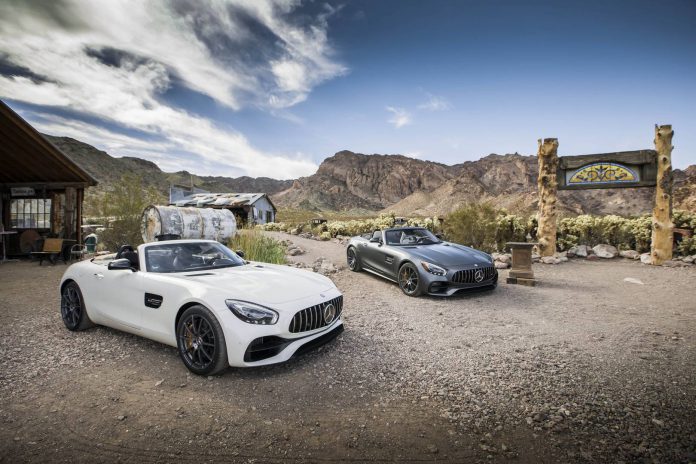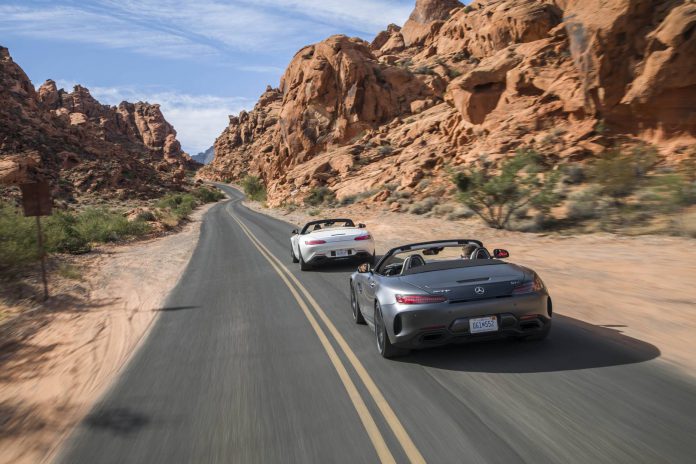AMG’s 911 killer doesn’t let off: Two years after the launch of the spectacular GT Coupe, Daimler’s high-performance sub-brand announced a drop-top derivative – and now we got a chance to ride along with AMG chief Tobias Moers late in the development process.
This particular drive took place in around around Las Vegas. The desert metropolis is predestinged for the GT Roadster: It symbolizes excess and glamour, and the contrast with the surrounding landscape is compelling: The bizarre rock formations and the grandiose canyons are accessible by beautiful open roads – some of which are rather lightly patrolled.
We call that perfect conditions for a spirited drive in these awesome cars – an entry-level GT Roadster, and a GT C Roadster. Las Vegas, by the way, wasn’t much of a detour: The cars were traveling anyway from the West Coast to proving grounds near Phoenix/Arizona. En route, there is famous Death Valley, where carmakers used to test their cars under extreme conditions. But it’s been reclaimed by the tourists: There is less and less testing; Moers tells us AMG was there for a final time last year: “We can test everything in Arizona.” Without cops, nosy tourists, and spy photographers.
The two variants Moers was kind enough to bring along mark the corner points of the lineup: The entry-level (wince) GT Roadster makes 456 horsepower; the GT C Roadster is rated at a full 550 horsepower. There will be a AMG GT S Roadster, too, rated at 503 horsepower, just like AMG will have a Mercedes-AMG GT C Coupe. Ah, the beauty of the corporate parts bin!
Convertibles are supposed to look pretty, but even at first glance, these roadsters look even more angry that their coupe siblings. That’s courtesy of the new grille, wide at the bottom and inspired by the classic 300 SL Panamericana – a real AMG styling element that was seen first on the GT R Coupe. It’s been slightly debased by the fact it features on the facelifted SL – including non-AMG versions. Nevertheless, it is impressive – and you would be correct to guess that it’ll soon appear on coupe versions of the AMG GT as well.
The Mercedes-AMG GT C Roadster isn’t just stronger than the GT Roadster: It sports a wider track, a wider body, and far-fetching chassis modifications. The “ride control” suspension is standard here, tires grow from 255/35 R 19 up front and 295/35 R 19 in the rear to 265/35 R 19 front and 305/30 R 20 abaft. The front brakes are stronger, there is an all-wheel steering system, and the transmission gains a “race” mode.
Visually, the main difference between the versions is in the rear: The GT C features vertical air outlets left and right, plus a horizontal slit between the taillights that we suspect doesn’t serve an indispensible function – but sure looks impressive.
It takes an expert at the wheel to notice and savor the differences between the GT Roadster’s different variations. Tobias Moers would be the perfect guy to do point them out. He knows cars; his career began at AMG when the manufacturer was not yet a treasured sub-brand of the Daimler juggernaut, but a barely tolerated tuner.
Inside, the AMG GT Roadster is barely changed from the coupe; the array of buttons on the ceiling has moved to the center console, otherwise it’s a familiar cabin. The command position is vitually perfect: The long front hood recalls classic front-engine sports cars, and when the fabric top is lowered, driving becomes an almost romantic experience.
But alas, not for the AMG chief: In this development stadium, he is checking all functions, their integration, and the overall harmony of the vehicle. It’s a few more months until the driving launch, and customers won’t get their cars before spring; the engineers are ironing out the details. Indeed, the trunk lid doesn’t fit well, and the steering isn’t calibrated for series production yet – and Moers noticed one or two more issues “that I won’t tell you about.”
No worries. They will be eliminated by the time this awesome roadster hits the market. And then things will get uncomfortable for the 911 Cabrio.

























































